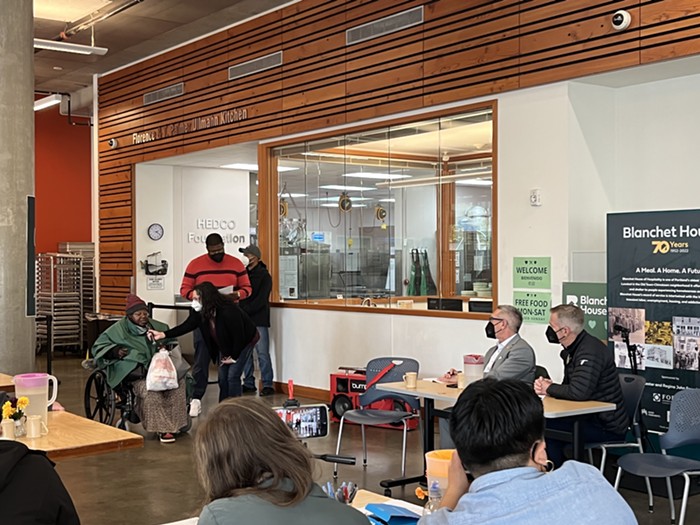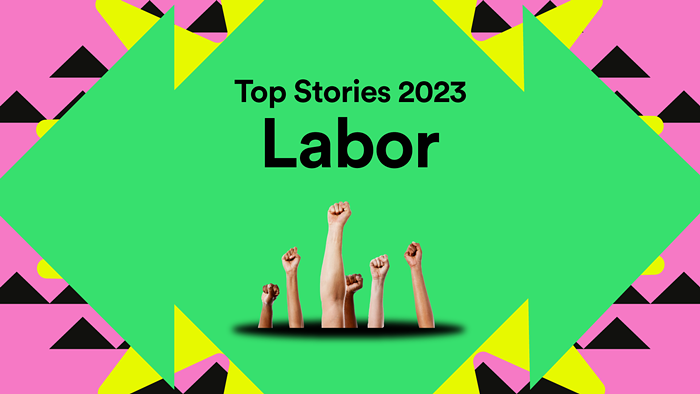28-year-old John has picked up a few essential tricks in his eight years of writing graffiti. Most importantly, he knows that when the police roll up, there is nothing better to do than run. "There's been a few times when I've had to turn into Carl Lewis," he explains. "I also like to go out when it rains; it makes you a little more invisible." In almost a decade of committing felonies, he's never been caught.
But on those nights, when he stuffs his backpack and coat full of spray paint, nozzles, and sketch books, John--not his real name--is actually doing what he considers to be a public service. Although he doesn't write that often (after eight years he doesn't want to press his luck), he still finds time to slip out of his daily activities for several hours each week.
On top of his normal job--a full-time, labor intensive position--John is an artist. Standing outside the gallery where his work is currently being shown, John appears more at home in a dark section of industrial Portland than under the fluorescent lights of the gallery. "[Graffitti] is art--just as much as anything else is," he says, shivering as rain runs down his face and into his coat. "And I work as much for the community as I do for myself. I'm worried about what people see when they're walking down the street, whether it's advertising, graffiti, or whatever. There is an idea that graffiti, because it's illegal, shouldn't be considered, that it's ugly. But what about everything else we see? I don't ask to see billboards when I'm walking down the street. Isn't advertising ugly too?"
John's Not the Only One Who's Worried
Artist Kristan Kennedy is also frustrated at the art she sees in Portland's streets. At least, that's the point she and her partner Topher Sinkinson are making in their latest project. They (along with John) are part of the Counter Canvas show at Portland Institute for Contemporary Art (PICA). Through the end of November, PICA will sponsor the show that consists of five different groups of artists who have art both in the gallery and on the streets.
But while PICA accepts grants from names as big as Nike, not to mention the months they spent collaborating with the city on this project, John acknowledges, "I think most people probably hate what I do. They see it as disrespectful, as vandalizing property. They think we're just some fuckin' kids causing trouble."
John and his friends have painted an entire gallery wall with spray paint, split it into sections and made it look like a graffiti asylum; every inch is covered in glossy reds, greens, blacks, and blues. The work is frenzied--a medley of different artists--yet it is organized, in a chaotic kind of way. A sign next to the wall reads, "These artists did not know when to stop."
The rest of the gallery walls are covered, but none are as detailed or as descriptive as the graffiti wall. Opposite from the graffiti is the work of Swallow Press, a billboard-size photo that takes up the entire 16' x 30' wall. It shows two girls in an abstract photo, and corresponds to similar billboards that the two artists have placed in public spaces. The sign reads, "How do you use space/How do you see space?/How do you take up space?/I take up space." Like John, the artists Sinkinson and Kennedy see their project as a kind of protest about what art is going where in Portland's streets.
"This show is an open letter to Vera, it is our letter to the editor, it is our neighborhood association meeting," they say. "We don't particularly enjoy not being able to see the river when we are walking by the Broadway Bridge because someone has built a huge cement stadium in our field of vision--but we walk a little further and there it is."
Working Outside the Box
The major difference between John's work and that of virtually any other kind of artist in America is that John doesn't need his audience to support him; he doesn't have to sell his work, make connections, or write grants. All he counts on is people seeing his work, and probably hating it.
Helen Lessick, on the other hand, aims to please. Another artist involved in Counter Canvas, Lessick says she actually enjoys working with, rather than against her audience. "I work from the inside, partnering with the supervisors of my canvas. Indeed, I try to build on structures and access available within public art. I embrace working within a sanctioned context, and delight in using the box as a framework for activity. I try to bring my sponsors into the exploration and questioning."
This difference between the two forms of art--one illegal and one not--means everything to how the public sees John's graffiti. "I know that people will disregard my work, will ignore it," he explains, "so lately I've been trying to make it mimic more classical art, to make people stop and say, 'Hey, that looks just like something I saw in a museum.'"
On the wall at the PICA gallery, one piece is painted with a few simple shapes. The piece could be a Cubist painting--it is simple, painted in a pastel green rather than the bright blues and reds of other pieces. "If anyone stops and looks at this, I mean really looks at this, they'll see that it's beautiful, by the same standards they might find a gallery piece beautiful." he explains.
Social Service or Public Nuisance?
Hugh McDowell is the Graffiti Prevention Coordinator for the City of Portland--a full-time job that probably keeps him thinking more about graffiti than John does. Like John, McDowell is committed to his own social service profession--scrubbing graffiti off the wall faster than John can put it up again. The two play a cat-and-mouse game, one that cost the city of Portland $2 million in 1998, and $13-$15 billion annually across the U.S. That's more than the city of Portland puts into any single public art project.
McDowell is a soft-spoken man with long hair, who organizes weekend crews of volunteers to scrub and paint, and says that he doesn't hate graffiti artists. "I do think they're disrespectful," he explains. "To the community, to people who volunteer to scrub their work off the wall, to business owners." McDowell and his staff keep computer databases of tags that show up regularly, so when they catch an offender they can link him to past work.
Listening to McDowell speak is like listening to one of the graffiti artists: "I'm just concerned about how the images we see affect us. It makes people feel unsafe to walk outside and see graffiti all around them."
While McDowell is concerned that graffiti makes people feel scared, John wants people to question the images they see on the street. Eric, a friend and fellow tagger of John, says, "Sure, I know that most people hate what I do. But what matters in art anyway? Being seen. Getting a reaction. They think we're useless, destroying their property."
McDowell couldn't agree more. "We had a woman in Gresham who called us; she was scared to go outside her house for fear of all the graffiti that was up. And this was a woman who had probably contributed to the community. It's a disgrace she felt the way she did," says McDowell, his head shaking in disapproval.
"Don't get me wrong," McDowell continues, "I'm all for art and creativity. My wife is an artist, in fact. But graffiti is not a legal way of expressing yourself. This isn't about expression at all. It's about the law."
One thing that McDowell and graffiti artists agree upon is that Portland takes graffiti laws very seriously. Last February, police arrested and charged a major graffiti offender, Aaron Reimer. He was sentenced to six months in jail--four felonies. Reimer fit the mold: a 19-year-old working class kid, attending Portland Community College on the side. His moniker, "Huge," still lingers on several walls around Portland.
And then in 1999, there was the infamous case of Sara Fisher, the Reed College student who was charged with 44 counts of unlawful applying of graffiti, paid almost $3000 in restitution, spent 400 hours on graffiti cleanup crews, and made four public apologies--one to the mayor. Fisher's easily recognizable tag, "Maul," was one of the most abundant in Portland.
Despite the extent of these punishments, graffiti artists are alive and thriving. "I think the pressure adds to the thrill," explains Eric.
But one might say there are legal ways of painting: Why not work in your garage? "You ask any graffiti artist, and that's their passion: being in the streets. Maybe they've gone somewhere else, been in the gallery, graphic design, etc., but this is what they'll love the most," John explains. "That's what they'll live for."
So What Does the Underground Look Like?
"I'm influenced quite a bit by my work in graphic design," one of the graffiti artists in Counter Canvas explains to me, pointing to a black and white six-foot, flower-like image on the graffiti wall in the gallery. It looks a lot like a primitive cartoon. Other artists there have attended Portland's graphic design school, PNCA.
Still, the use of graffiti by advertisers and media relies on John breaking the law. "As long as graffiti is illegal, it will be cool," says John.
"Because what we're doing is illegal, we're always going to be the voice of the underground," Eric explains.
Not only is it the respect granted from other artists, but it's also the fact that the city spends so much money on them that keeps them writing, or "bombing," as they often say. Even the efforts of McDowell and his crew add value to each piece of work that goes up. Because of the circumstances in which it's done, graffiti becomes, literally, the cutting edge--work that's up for so short of a time and done under such extreme pressure, it sets the standard of rebellion and what's considered underground.
According to most Portland artists, graffiti is not about violence or gangs. "The most popular kind of graffiti is the kind that looks like letters, that's the most old school," explains a Counter Canvas artist. "But I like to think we're moving away from that, into stuff that's more challenging." Because it's the most old school kind of graffiti, it's also the most popular, and is used and referenced on trains and buildings all over the nation.
On the PICA wall, this is the most common theme--there are at least three different kinds of letters, deconstructed fonts and typefaces that are mixed up with bright color schemes. They're similar, but clearly different enough to show the hand and style of distinct artists.
Probably the most common kind of graffiti today is tagging. "Everyone starts with just a tag," explains one artist. "And then they learn from there." Tagging is a kind of gateway graffiti because it's a relatively safe way to start; one of the biggest considerations in graffiti is the time restriction. Unlike painters who spend hours toiling at their canvas, graffiti artists must learn to apply their skill as quickly as possible. Time becomes a resource as much as paint, walls, and brushes.
Consequently, tags, simple and quick, show up everywhere. While they're easy, their presence also makes a name for the artist, introducing him to the community. These tend to show up, most often, in highly visible places. "It's mostly in Southeast Portland that we find graffiti," explains McDowell. "There's a misconception that graffiti is associated with the poorest parts of town. That's not true at all."
This misconception is probably due, in part, to the fact that graffiti is often not written by poor people. "I'd say half of the kids you've got out here are rich suburban kids, white kids," says John. Both Reimer and Fisher were college students, people who had money to pay tuition.
"I think graffiti shows up most often where it can be easily seen," explained McDowell. McDowell's theory is verified by graffiti artists. "In the end, it's not really about changing what people think, because everyone besides your friends is going to think it sucks," shrugs one of the Counter Canvas artists. "After all, who cares, because who's to say what art is good. It's not about making people think you're good. It's about your friends seeing it, and other people noticing it."
Artists or Not, They're Still Annoying
For all their self-perceived social service and vision, graffiti artists tend to annoy people no matter what. At the Counter Canvas show, curator Kristy Edmunds said her mission was "to bring different groups of artists together, to generate conversation between two factions of artists." Yet, on the opening night of the show, a graffiti artist committed the ultimate act of disrespect to a gallery artist: tagging another part of the show within gallery walls.
The very same posters that were tagged--fluorescent pink pictures superimposed with black and white images of ears, noses, and fingers--were pasted all over street walls, where they had been tagged, torn down, and modified just as expected. Yet, once in the gallery, where the signs became property of PICA, museum administrators glowered disapprovingly as they washed the tags off, just minutes after they were put up.
What's more, the graffiti artists didn't seem to be engaging in much discussion with their fellow PICA members. "To tell you the truth, I could've done much better. I just thought I was going to be paid more," explains one of the graffiti artists snidely. "I work mostly outside, hardly ever in here," he continues. "This is not what graffiti is about." And though a few graffiti artists chat it up with some of the other artists, they generally stand out, and form cliques like high school students. The well-dressed, first Thursday crowd sifts in, drinks and eats, while the younger kids hang out in the corner. A quick look at what someone is wearing when they walk in the door, who they're with, how old they are, and it is immediately apparent who has come to see what.
However, without the gallery, there's no legal way to tag. "I try to tell my friends, to warn them, that once you start graffiti, you'll absolutely never stop until you get caught," warns Eric. "Me, I try to move around, go city to city. That way, they can't have too much of a record on you." Even so, without a change in attitude or a change in law, this crew is destined either for arrest, or for creative retirement.
"When it comes to my art, opinions don't matter anyway," asks Eric. "In the end, you're never going to convince people to like it, so you should just do what turns you on, or what you think is beautiful. That's more than what I see anywhere else."












